As a dedicated gardener or a seasoned farmer, one of your top priorities is ensuring your celery crops’ thriving health. However, battling pests and diseases can be a daunting challenge. Fear not! This blog will provide easy-to-implement and effective strategies to safeguard your celery from potential threats. From identifying common pests to understanding disease prevention and practicing tips for control, celery management, and secure harvest!
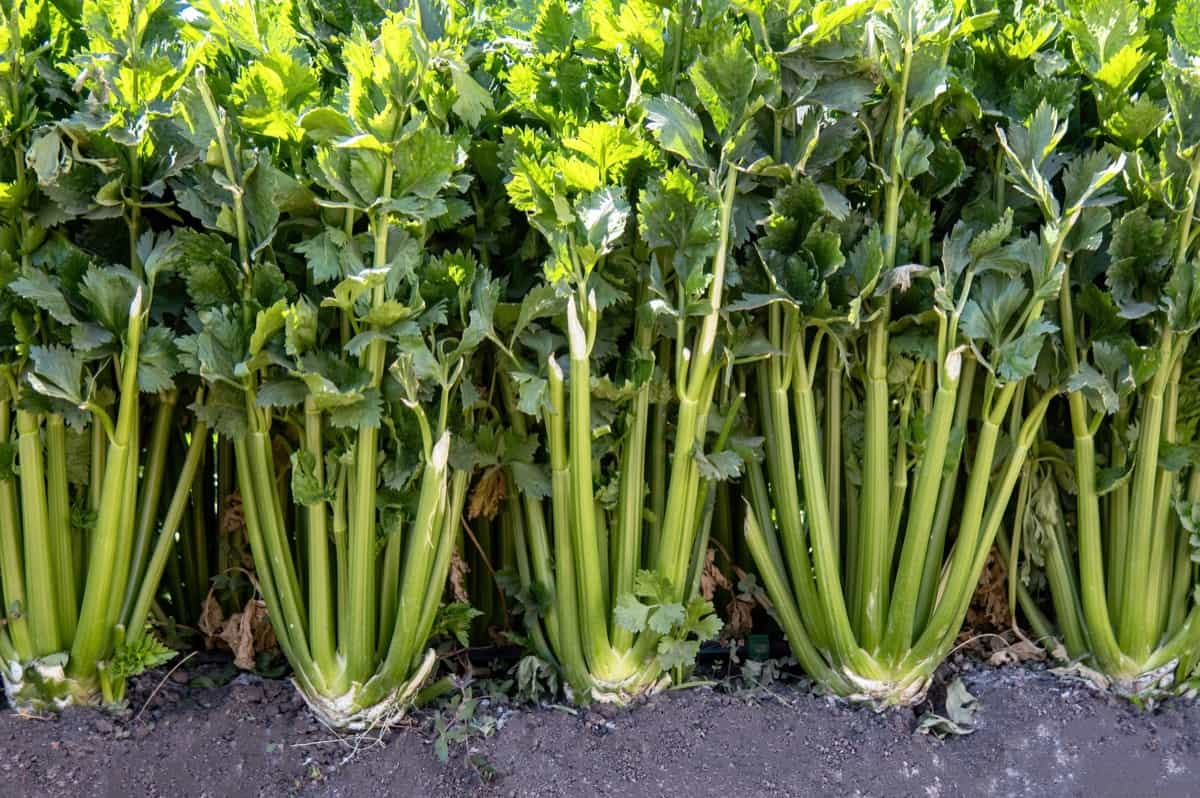
How to Identify and Control Celery Pests and Diseases
What is Celery?
Celery (Apium graveolens) is a versatile biennial plant from the Apiaceae family, prized for its stalks and taproot used as vegetables worldwide. It features rhombic leaves growing in rosettes on a ribbed central stem and produces creamy white flowers in dense umbels, giving rise to oval seeds.
The celery stalks are the most consumed part, offering a refreshing and crunchy texture, while the leaves are used for seasoning and garnishing due to their aromatic nature. Its health benefits include promoting digestion, heart health, and weight management. Celery is typically grown annually, reaching up to 1 meter in height, and is sometimes referred to as celeriac due to its edible root.
Originating in the Eastern Mediterranean, this cool-season vegetable thrives in well-draining, fertile soils with a pH of 6.0-6.8. It prefers cool, moist climates and requires constant moisture with temperatures between 5°C to 27°C (41–80.6°F). For successful cultivation, celery seeds are often planted indoors or in greenhouses, transplanted after 10-12 weeks, and placed 15–20 cm (6–8 in) apart in rows. Regular feeding, watering, and blanching are essential for healthy growth, and harvesting can begin when stalks reach around 20 cm (8 in) in height.
Common Celery Pests
Common celery pests include insects, mites, and beet armyworms, which can defoliate celery plants. Black bean aphids suck sap from leaves, causing wilting and stunted growth. Foxglove aphids target young plants, causing distorted leaves. Leafminers tunnel through leaves, leaving unsightly trails and reducing their photosynthesizing ability. Lygus bugs pierce stems, causing discoloration and deformation. Other aphid species attack celery, causing similar damage to leaves and stems. Nematodes infest celery roots, hindering water and nutrient uptake and weakening plants.
Common Celery Diseases
- Apium Virus Y: A viral infection that causes yellowing and stunted growth in celery plants.
- Aster Yellows: Another viral disease characterized by yellowing and abnormal celery growth.
- Bacterial Leaf Spot: Caused by bacteria, this disease leads to small, water-soaked lesions on celery leaves.
- Celery Mosaic Virus: A viral infection that results in mottled and distorted foliage.
- Crater Rot: This fungal disease causes circular, sunken lesions on celery stalks.
- Early Blight: A fungal infection causing brown spots on celery leaves and stems.
- Fusarium Yellows: A fungal disease causing yellowing and wilting of celery.
- Late Blight: Another fungal infection leading to dark, water-soaked spots on celery leaves.
- Other Virus Diseases: Viral infections that can affect celery health.
- Pink Rot: A fungal disease causing pinkish lesions on celery stalks.
In case you missed it: Growing Celery In Containers, Pots, Backyards At Home
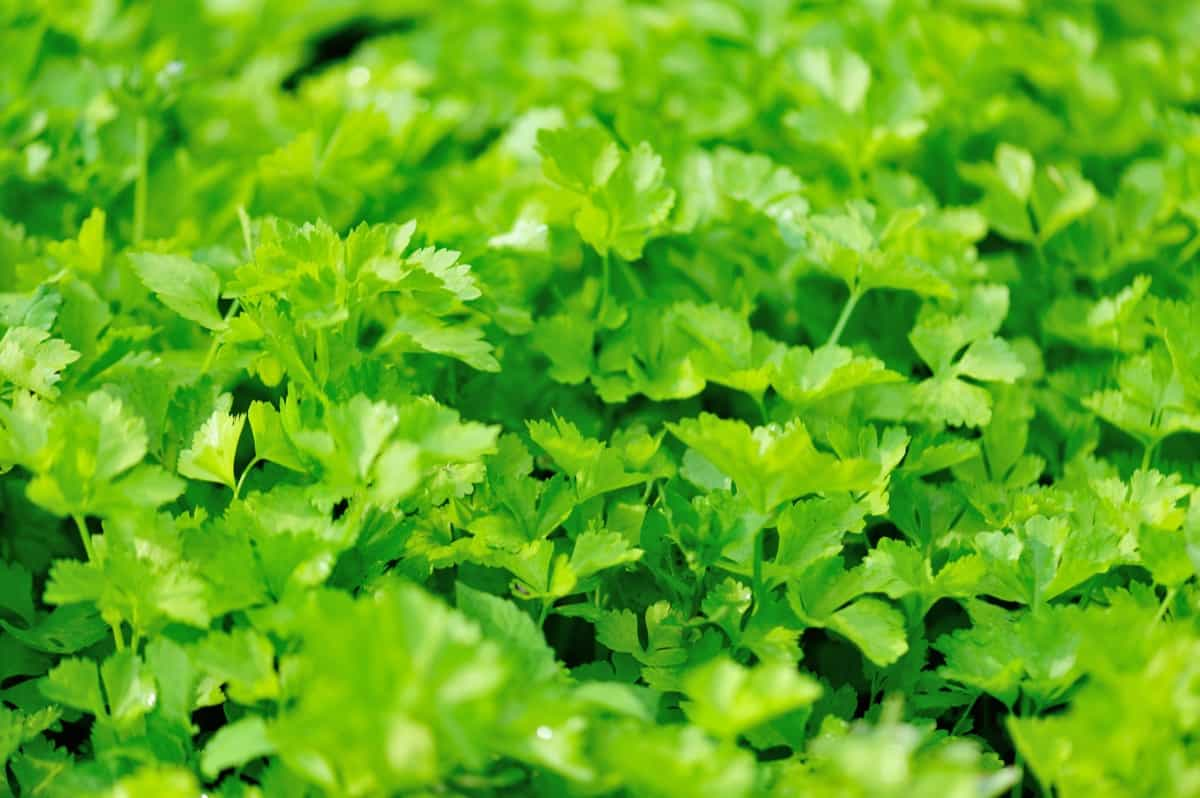
Celery Pest Control
Regularly inspect celery plants and remove pests manually. Use row covers to shield celery from insects. Plant pest-repelling plants like marigolds nearby. Apply neem oil, diatomaceous earth, garlic spray, floating row covers, nematodes, horticultural oils, beer traps, handwashing, mulching, trap crops, introduce beneficial insects to prey on pests, and finalize chemical pest control measures.
Managing Celery Diseases
Choose well-drained, sunny locations; rotate with other crops; remove debris; choose disease-resistant varieties; avoid overwatering; maintain adequate space; monitor plants regularly; implement IPM practices and quarantine; use soil solarization; apply organic mulch; introduce beneficial microorganisms; manage temperature, and clean and disinfect equipment after harvest.
Integrated Pest Management for Celery
Integrated Pest Management (IPM) for celery is a holistic, environmentally-friendly approach to controlling pests while minimizing their impact on beneficial organisms and the ecosystem. It combines various techniques to reduce reliance on chemical pesticides. IPM involves monitoring, pest identification, cultural practices, biological control, mechanical control, chemical control, threshold levels, record keeping, education, and economic threshold assessment. By implementing IPM, celery can maintain a healthy ecosystem and reduce the need for chemical pesticides.
Organic Methods for Controlling Celery Pests
Organic methods for controlling celery pests offer environmentally-friendly solutions that minimize harm to beneficial organisms and ensure the safety of the produce. Strategies include crop rotation, companion planting, beneficial insects, neem oil spray, insecticidal soap, diatomaceous earth, physical barriers, handpicking, homemade remedies, and traps. Crop rotation involves rotating celery with different plant families, while companion planting involves growing pest-repelling plants.
Beneficial insects, such as ladybugs, lacewings, prey harmful pests. Neem oil spray is a natural insecticide, while insecticidal soap suffocates soft-bodied insects like aphids and thrips. Diatomaceous earth is sprinkled around celery plants, and physical barriers like floating row covers or mesh nets protect celery from flying insects. Handpicking and homemade remedies can also be used to deter pests.
Preventing Celery Plant Diseases
- Start with clean planting material.
- Maintain a tidy cultivation area.
- Choose well-draining and sunny locations.
- Rotate celery with other plant families.
- Treat seeds with hot water or fungicides.
- Choose disease-resistant varieties.
- Avoid overhead irrigation.
- Regularly remove debris and weeds.
- Allow sufficient spacing.
- Implement Integrated Pest Management (IPM).
- Harvest mature celery at the appropriate time to prevent over-ripening and disease development.
In case you missed it: Cacao Farming in Ghana: Varieties, Requirements, and Techniques
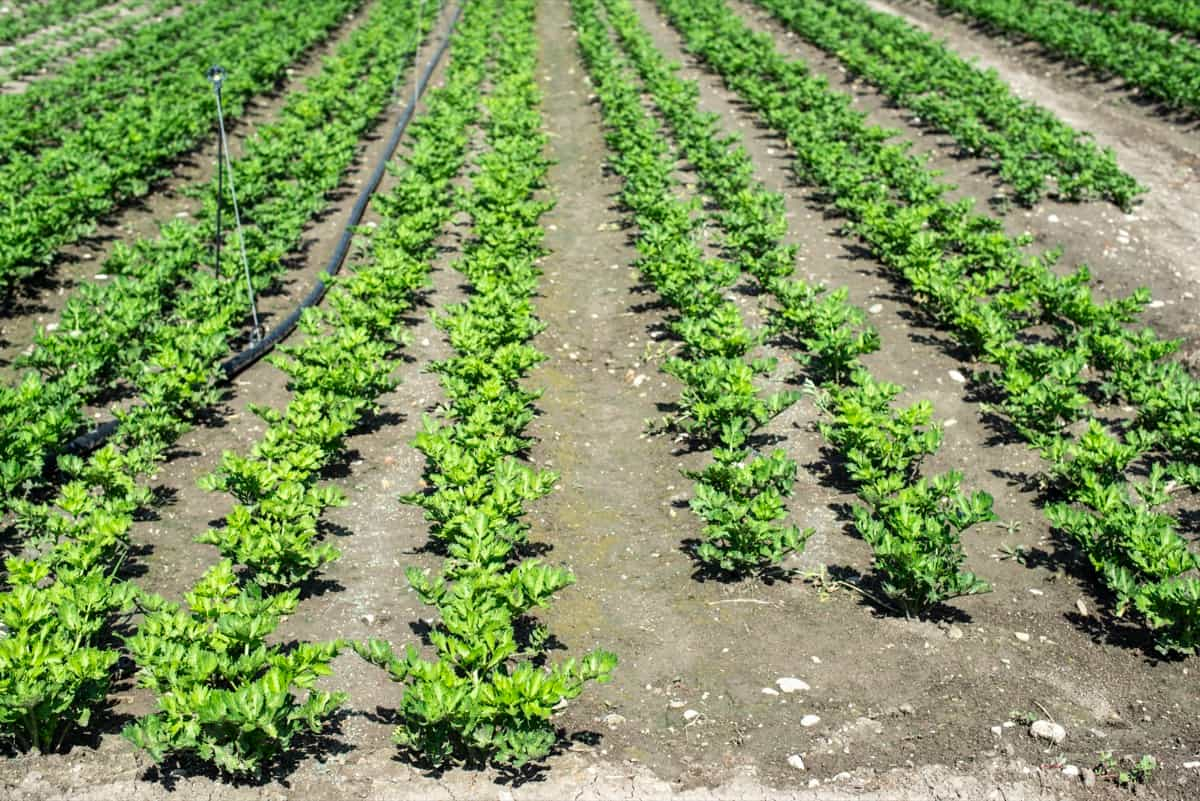
Identifying Celery Plant Pests
Identifying celery plant pests, particularly insects and nematodes, is crucial for effective pest management. Aphids are common insect pests, including the Carrot-willow, Peach, Hawthorn, and Melon aphids. Aphids are small, soft-bodied insects usually found on the underside of leaves and stems. They secrete honeydew, attracting sooty mold and causing leaf yellowing, distortion, and stunted growth.
Another insect pest is the Armyworm, characterized by circular holes in foliage and skeletonized leaves. Their egg clusters are cottony and can go through multiple generations in a year. As for nematodes, the Root-knot nematode causes galls on celery roots, leading to reduced plant vigor, wilting, and yellowing.
Managing these pests organically is essential. Pruning infested areas, using tolerant varieties, and spraying sturdy plants with water can help control aphids. Biological control, such as Bacillus thuringiensis, and solarizing soil can be effective against armyworms and root-knot nematodes.
Identifying Celery Plant Diseases
- Bacterial Blight and Brown Stem: Water-soaked spots on leaves, circular or angular necrotic lesions with chlorotic halos, brown discoloration, and streaks on petioles.
- Soft Rot: Water-soaked lesions near the base of petioles that become soft, sunken, and brown.
- Celery Mosaic: Vein clearing and mottling on leaves, twisted, curled, or cupped leaves, dark green mottling on petioles, stunted young plants.
- Damping-off: Soft, rotting seeds, rapid death of seedlings before emergence, seedlings collapse due to water-soaked lesions at the stem-soil line.
- Downy Mildew: Yellow spots on upper leaf surfaces, white fluffy growth on the underside, darker lesions with prolonged leaf wetness.
- Early Blight: Small yellow flecks on leaves that enlarge to brown-gray spots, papery lesions, and necrotic leaves.
- Fusarium Yellows: Severely stunted, yellowing plants with brown water-soaked roots and discolored vascular tissue in stems.
- Late Blight (Septoria Leaf Blight): Irregular chlorotic spots on leaves and petioles, necrotic areas, and back fungal fruiting bodies visible.
- Pink Rot: Soft, brown lesions with pink margins on stalks, causing rot and collapse of the stalk; black fungal fruiting bodies visible.
- Powdery Mildew: Powdery growth on chlorotic leaves and distorted flowers.
In case you missed it: The Sustainable Solution: Bio-composting with Agricultural By-products
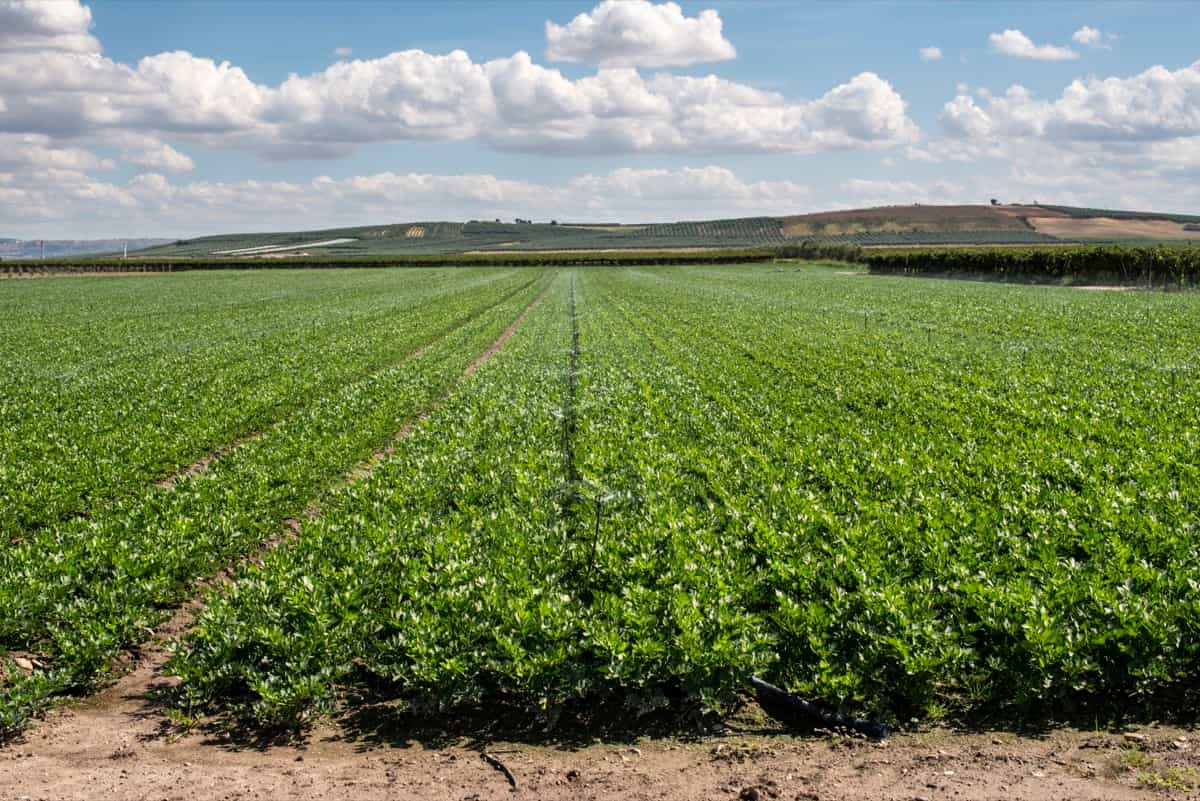
Chemical-free Solutions for Celery Pest Management
Chemical-free solutions for celery pest management offer environmentally friendly and sustainable alternatives to conventional pesticides. Organic gardening experts offer effective methods to protect celery crops naturally. Combination planting, beneficial insects, physical barriers, handpicking, traps, neem oil spray, insecticidal soap, diatomaceous earth, crop rotation, sanitation, and disease prevention are all effective methods for controlling pests.
Additionally, proper watering and planting practices can minimize disease risks. By implementing these methods, celery plants can thrive and provide a healthier environment for their growth.
Biological Control of Celery Pests
- Beneficial Insects: Introduce predator insects like ladybugs, lacewings, and parasitic wasps to prey on celery pests such as aphids, caterpillars, and mites.
- Nematodes: Use beneficial nematodes to target soil-dwelling pests like root-knot nematodes, reducing their populations.
- Birds: Encourage birds like sparrows and robins in your garden to feed on harmful insects.
- Bacillus thuringiensis (Bt): Apply Bt, a natural bacterium for control caterpillar pests without harming beneficial insects.
- Trap Crops: Plant specific crops to attract pests away from celery, protecting the main crop.
- Microbial Inoculants: Introduce beneficial microbes to the soil, enhancing its ability to suppress pest populations.
- Fungal Pathogens: Use entomopathogenic fungi to infect and control insect pests.
Fungal Diseases in Celery Plants
Downy Mildew (Peronospora umbelliferous): Yellow spots on leaves with white fluffy growth underneath; lesions darken as they mature. Manage with pathogen-free seed, avoid overcrowding, and rotate with non-umbelliferous crops.
Early Blight (Cercospora apii): Small yellow flecks on leaves enlarge to brown-gray spots with no defined border, lesions become papery, and leaves may die. Control with pathogen-free seed, crop rotation, and avoiding overcrowding. Fungicides can be applied if necessary.
Fusarium Yellows (Fusarium oxysporum): Yellowing, severely stunted plants, brown and water-soaked roots, and vascular tissue discoloration. Prevent by sanitizing tools, using pathogen-free soil, and planting resistant varieties.
Late Blight (Septoria capicola): Irregular chlorotic spots on leaves and petioles turning necrotic, large necrotic areas, and leaf blight. Use pathogen-free seed, fungicide treatments, and avoid working in wet conditions.
Pink Rot (Sclerotinia scerlotiotum): Soft, brown lesions with pink margins causing stalk rot and collapse. Control with cultural practices like drip irrigation and fungicide use when needed.
Powdery Mildew (Erisyphe heraclei): Powdery growth on leaves, petioles, flowers, chlorotic leaves, and distorted flowers. Manage with tolerant varieties, proper fertilization, fungicides, and sulfur application if infection occurs early.
In case you missed it: How to Treat Sweet Potato Pests and Diseases: Management, Control, and Prevention
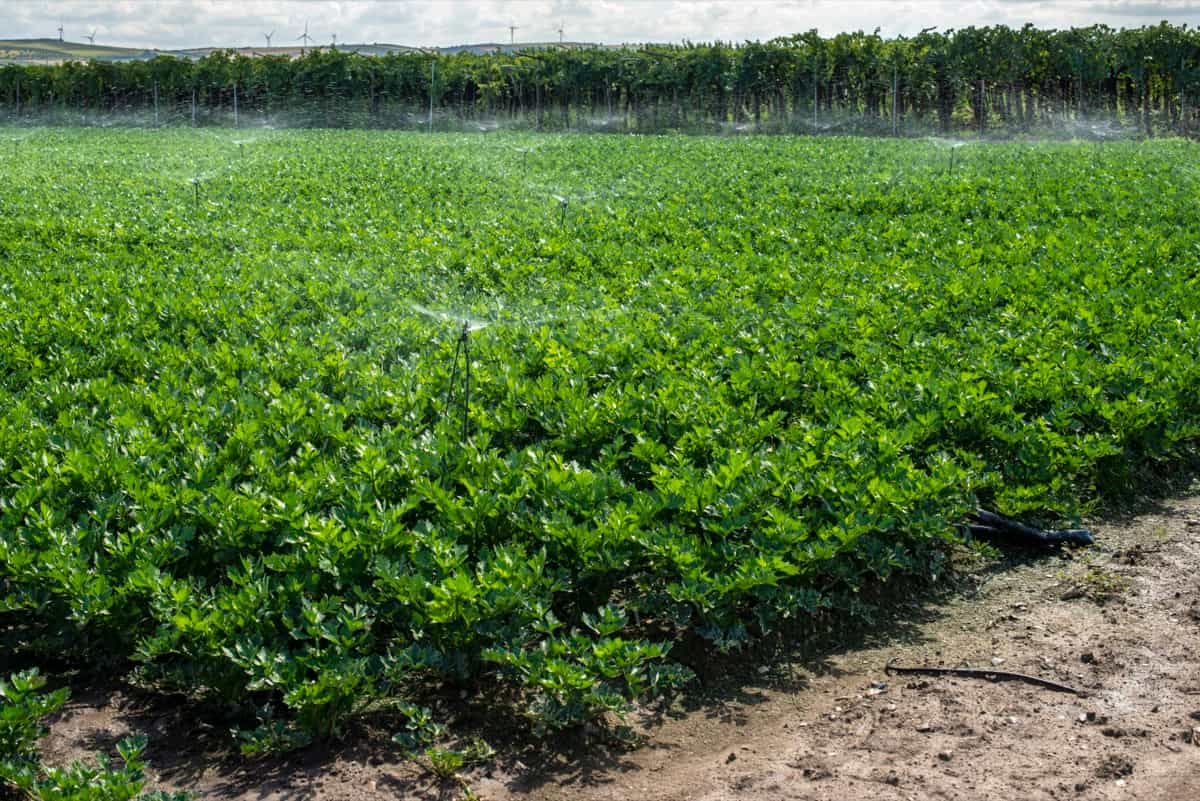
Insect Pests Affecting Celery Crops
Aphids (Carrot-willow aphids, Peach aphids, Hawthorn aphids, Melon aphids – Cavariella aegopodii, Myzus persicae, Dysaphis apiifolia, Aphis gossypii): Small soft-bodied insects on leaves and stems, green or yellow (may vary), heavy infestations cause yellowing, distorted leaves, and sticky honeydew that promotes sooty mold growth. Prune infested leaves, check transplants for aphids before planting, use tolerant varieties, reflective mulches, and strong water spray, and consider insecticidal soaps or oils for high infestations.
Armyworm (Pseudaletia unipuncta): Symptoms: Circular holes in foliage, skeletonized leaves, wounds on fruit, egg clusters covered in white scales, and larvae with green or yellow coloration. Cause: Insect Management: Use natural enemies and Bacillus thuringiensis for organic control; commercial chemicals may be ineffective.
Nematode Control in Celery Cultivation
Nematodes, especially the root-knot nematode (Meloidogyne spp.), can cause significant damage to celery plants. Look for galls on the roots, which may be as large as 3.3 cm (1 inch) but are typically smaller. Affected plants show reduced vigor, yellowing, and wilting in hot weather. Galls can develop as early as a month before planting. Nematodes prefer sandy soils, and damage is more likely in such areas.
Management: Plant-resistant celery varieties if nematodes are present in the soil. Regularly check plant roots during the growing season or even earlier if symptoms suggest nematode presence. Soil solarization can help reduce nematode populations and the levels of other harmful pathogens.
Bacterial Infections in Celery Plants
Bacterial Blight And Brown Stem
- Symptoms: Small water-soaked spots on leaf blades turning necrotic, with circular or angular shapes and a chlorotic halo. The brown stem shows brown discoloration on petioles and streaks.
- Cause: Bacterium Pseudomonas cichorii. Close plant spacing facilitates bacterial spread, and severe symptoms occur above 30°C (86°F).
- Management: Challenging to control; copper sprays are used in commercial plantations. Planting less susceptible celery varieties and trimming leaves when dry can help reduce transmission.
Soft Rot
- Symptoms: Small water-soaked lesions near the base of petioles, becoming soft, sunken, and brown.
- Cause: Bacteria Erwinia carotovora, Erwinia chrysanthemi, and Pseudomonas marginalis. Bacteria thrive in oxygen-depleted plant tissue and need prolonged water-saturated soil. Entry occurs through wounds.
- Management: Prevent bacterial infection by using well-draining soils, allowing plants to dry before irrigating, and avoiding post-harvest wounding. Regular equipment disinfection is essential.
In case you missed it: Red Rice Farming Practices: From Seed to Harvest
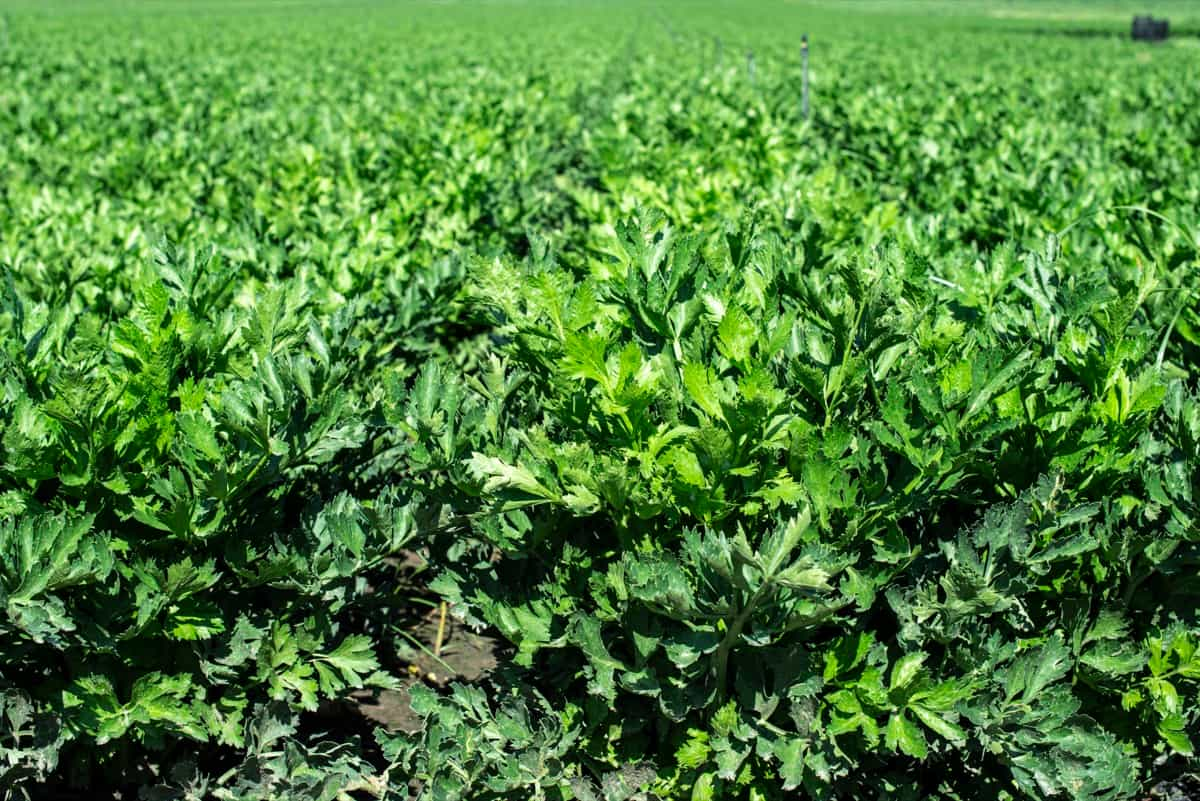
Viral Diseases in Celery Crops
Celery Mosaic
- Symptoms: Vein clearing and mottling in leaf areas between veins, leading to twisted, curled, or cupped leaves. Dark green mottling may also appear on petioles, and young plants may be stunted.
- Cause: Virus (Celery mosaic virus).
- Comments: Various aphid species can infect plants within 30 seconds of feeding on them, which is how the virus spreads. Symptoms typically emerge within ten days of primary infection.
- Management: Controlling this viral disease involves implementing a ‘celery-free’ period of 1-3 months. Additionally, managing umbelliferous weeds, which can harbor the virus and serve as a source of inoculum, is crucial to prevent its spread.
Conclusion
Effectively managing celery pests and diseases is crucial for healthy crop growth and higher yields. Integrating pest management practices, biological controls, and early detection strategies can help mitigate the impact of pests and diseases, ensuring successful celery cultivation.
- Types of Pesticides Used in Agriculture: A Beginner’s Guide
- Economical Aquaculture: A Guide to Low-Budget Fish Farming
- 15 Common Planting Errors That Can Doom Your Fruit Trees
- How to Make Houseplants Bushy: Effective Tips and Ideas
- Innovative Strategies for Boosting Coconut Pollination and Yield
- Pollination Strategies for Maximum Pumpkin Yield
- The Complete Guide to Chicken Fattening: Strategies for Maximum Growth
- Natural Solutions for Tulip Problems: 100% Effective Remedies for Leaf and Bulb-Related Issues
- Revolutionizing Citrus Preservation: Towards a Healthier, Greener Future
- Natural Solutions for Peony Leaf and Flower Problems: 100% Effective Remedies
- Maximizing Profits with Avocado Contract Farming in India: A Comprehensive Guide
- Natural Solutions for Hydrangea Problems: 100% Effective Remedies for Leaf and Flowers
- The Ultimate Guide to Choosing the Perfect Foliage Friend: Bringing Life Indoors
- From Sunlight to Sustainability: 15 Ways to Use Solar Technology in Agriculture
- The Ultimate Guide to Dong Tao Chicken: Exploring from History to Raising
- The Eco-Friendly Makeover: How to Convert Your Unused Swimming Pool into a Fish Pond
- Mastering the Art of Delaware Chicken Farming: Essentials for Healthy Backyard Flocks
- 20 Best Homemade Fertilizers for Money Plant: DIY Recipes and Application Methods
- How to Craft a Comprehensive Free-Range Chicken Farming Business Plan
- Brighten Your Flock: Raising Easter Egger Chickens for Beauty and Bounty
- How to Optimize Your Poultry Egg Farm Business Plan with These Strategies
- Subsidy for Spirulina Cultivation: How Indian Government Schemes Encouraging Spirulina Farmers
- Ultimate Guide to Raising Dominique Chickens: Breeding, Feeding, Egg-Production, and Care
- Mastering the Art of Raising Jersey Giant Chickens: Care, Feeding, and More
- Ultimate Guide to Raising Legbar Chickens: Breeding, Farming Practices, Diet, Egg-Production
- How to Raise Welsummer Chickens: A Comprehensive Guide for Beginners
- How to Protect Indoor Plants in Winter: A Comprehensive Guide
- Ultimate Guide to Grow Bag Gardening: Tips, Tricks, and Planting Ideas for Urban Gardeners
- Guide to Lotus Cultivation: How to Propagate, Plant, Grow, Care, Cost, and Profit
- Agriculture Drone Subsidy Scheme: Government Kisan Subsidy, License, and How to Apply Online
- Ultimate Guide to Raising Araucana Chickens: Breed Profile, Farming Economics, Diet, and Care
- Bringing Hydroponics to Classroom: Importance, Benefits of Learning for School Students
- Ultimate Guide to Raising Polish Chickens: Breed Profile, Farming Economics, Diet, and Care
- Ultimate Guide to Raising Australorp Chickens: Profile, Farming Economics, Egg Production, Diet, and Care
- Silkie Chicken Farming: Raising Practices, Varieties, Egg Production, Diet, and Care
- Sussex Chicken Farming: Raising Practices, Varieties, Egg Production, Diet and Care